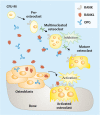Pathophysiology of Bone Remodelling and Current Therapeutic Approaches
- PMID: 25284839
- PMCID: PMC4168398
- DOI: 10.1055/s-0032-1314943
Pathophysiology of Bone Remodelling and Current Therapeutic Approaches
Abstract
Different metabolic bone parameters such as RANK (receptor activator of nuclear factor-κB), RANK ligand (receptor activator of nuclear factor-κB ligand) and OPG (osteoprotegerin) control physiological bone remodelling. The pathophysiology of these factors in bone diseases and osseous metastases is becoming clearer. In metastatic breast cancer, osteolytic bone metastases are the result of increased osteoclastic activity caused either by increased RANK ligand or decreased OPG expression of metastatic osseous tumour cells. These findings may lead to new therapeutic options for the treatment of breast cancer patients. The aim of this work is to provide an overview of physiological bone remodelling and of the interaction between tumour cells and bone environment. Current therapy approaches and the mechanisms of action of drugs are described.
Das physiologische Knochen-Remodelling unterliegt u. a. der Steuerung durch die Knochenstoffwechselparameter RANK (receptor activator of nuclear factor-κB), RANK-Ligand (receptor activator of nuclear factor-κB ligand) und OPG (osteoprotegerin). Auch die pathophysiologische Beteiligung dieser Faktoren bei ossär bedingten Erkrankungen wird zunehmend klarer. Beim Mammakarzinom wird die Entstehung von osteolytischen Knochenmetastasen durch eine gesteigerte Osteoklastenaktivität verursacht, die durch übermäßige direkte RANK-Ligand- oder reduzierte OPG-Expression ossär metastasierter Tumorzellen mitbedingt ist. Diese Erkenntnisse ermöglichen nebst dem Einsatz etablierter Therapieverfahren neue Therapieoptionen in der Behandlung von Mammakarzinompatientinnen. Ziel dieser Arbeit ist es, einerseits einen Überblick über das physiologische Knochen-Remodelling zu geben. Zudem soll die Wechselwirkung zwischen Tumorzelle und dem Knochenmilieu dargestellt werden. Ferner sollen aktuelle Therapieansätze vorgestellt und Wirkmechanismen der Therapeutika näher erläutert werden.
Keywords: RANK; bone metastases; bone remodelling; bone targeted therapy; breast cancer.
Conflict of interest statement
Figures
References
-
- Bikle D D. Growth hormone/insulin-like growth factor-1/PTH axis in bone. J Bone Miner Res. 2008;23:581–583. - PubMed
-
- Boyle W J, Simonet W S, Lacey D L. Osteoclast differentiation and activation. Nature. 2003;423:337–342. - PubMed
-
- Coleman R E, Marshall H, Cameron D. et al.Breast-cancer adjuvant therapy with zoledronic acid. N Engl J Med. 2011;365:1396–1405. - PubMed
LinkOut - more resources
Full Text Sources


